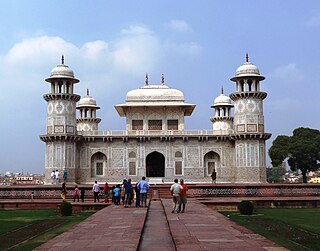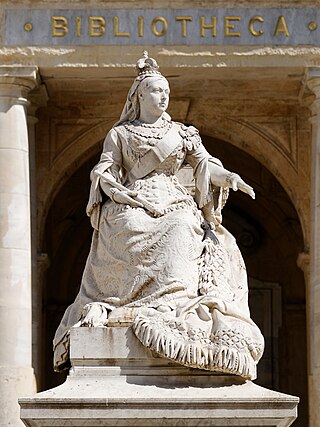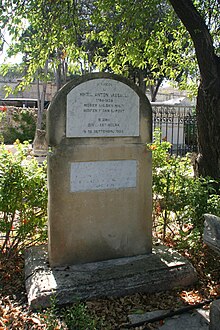
A tomb is a repository for the remains of the dead. It is generally any structurally enclosed interment space or burial chamber, of varying sizes. Placing a corpse into a tomb can be called immurement, although this word mainly means entombing people alive, and is a method of final disposition, as an alternative to cremation or burial.

Floriana, also known by its title Borgo Vilhena, is a fortified town in the South Eastern Region area of Malta, just outside the capital city Valletta. It has a population of 2,205 as of March 2014. Floriana is the birthplace of many famous Maltese, amongst which the composer of the national anthem, 'L-Innu Malti', Robert Samut; former Bishop of Malta Dun Mauro Caruana, the poets Oliver Friggieri and Maria Grech Ganado, the writer and politician Herbert Ganado and Swedish Idol winner Kevin Borg.

Ta' Xbiex is a locality and Local Council in the Central Region of Malta with a population of 2148 It is part of a small headland within the Marsamxett Harbour, right between the villages of Msida and Gżira.

John Hookham Frere was an English diplomat and author.

Pietà is a small town in the Central Region of Malta, located near the outskirts of the capital city Valletta. Pietà is the suburb next-closest to the capital after Floriana. Its name is derived from Italian and signifies "Pity."

Paola is a town in the South Eastern Region of Malta, with 8,706 inhabitants as of 2019. The town is a commercial centre in the Southern Harbour area of Malta, about 5 km from the capital Valletta, contiguous to Tarxien and Fgura, with which it forms a single urban area. Paola is named after Grand Master Antoine de Paule, who laid the foundation stone in 1626.

Wignacourt Tower, also known as Saint Paul's Bay Tower, is a bastioned watchtower in St. Paul's Bay, Malta. It was the first of six Wignacourt towers to be built, and the first stone was laid on 10 February 1610. It replaced the role of Ta' Tabibu farmhouse which was previously known as Dejma Tower. An artillery battery was added a century later in 1715. Today the tower is a museum of fortifications around the Maltese Islands.
Mikiel Anton Vassalli was a Maltese writer, a philosopher, and a linguist who published important Maltese language books, including a Maltese-Italian dictionary, a Maltese grammar book, the first Protestant Gospels in Maltese, and towards the end of his life, a book on Maltese proverbs.

The Floriana Lines are a line of fortifications in Floriana, Malta, which surround the fortifications of Valletta and form the capital city's outer defences. Construction of the lines began in 1636 and they were named after the military engineer who designed them, Pietro Paolo Floriani. The Floriana Lines were modified throughout the course of the 17th and 18th centuries, and they saw use during the French blockade of 1798–1800. Today, the fortifications are still largely intact but rather dilapidated and in need of restoration.

Hastings Gardens is a public garden in Valletta, Malta. It is located on top of St. John's Bastion and St. Michael's Bastion, on the west side of the City Gate. The garden offers views of Floriana, Msida, Sliema, and Manoel Island. Inside the garden is a monument placed by the Hastings family in honor of Francis, Marquis of Hastings, who was a governor of Malta. Lord Hastings died in 1826 and is buried in the garden.
The Lascaris Towers are a series of mostly small coastal watchtowers built in Malta by the Order of Saint John between 1637 and 1652. The first seven towers were built around the coast of mainland Malta between 1637 and 1638. Between 1647 and 1652, a large tower was also built on mainland Malta, and two smaller ones were built on Gozo.

Din l-Art Ħelwa is a non-governmental and non-profit, voluntary organisation founded in 1965 by Maltese Judge Maurice Caruana Curran to safeguard Malta's cultural heritage and natural environment. Since its foundation, Din l-Art Ħelwa has restored numerous cultural sites of historic and environmental importance and currently has the guardianship of a number of them. Many of the sites are open to visitors and for events, all thanks to an army of dedicated volunteers. The organisation promotes the preservation and protection of historic buildings and monuments, the character of Malta's towns and villages, and places of natural beauty. It is very active in campaigning against proposed construction which infringes planning laws or policies, and regularly objects to planning applications, taking legal action to halt development in some cases. The NGO stimulates the enforcement of existing laws and the enactment of new ones for the protection of Malta's natural and built heritage.
HMS Castor, launched and commissioned in 1832, was a 36-gun fifth rate frigate of the Royal Navy and the third naval ship to bear the name.

Sciuta Tower, also known as Sciutu Tower or Wied iż-Żurrieq Tower, is a small watchtower in Qrendi, Malta. It was completed in 1638 as the fifth of the Lascaris towers. The tower was restored by Din l-Art Ħelwa.

The Chapel of the Annunciation is a Medieval Roman Catholic church located in Ħal-Millieri, limits of Żurrieq, Malta.

The Turkish Military Cemetery, also known as the Ottoman Military Cemetery, is a cemetery in Marsa, Malta. Commissioned by the Ottoman sultan Abdülaziz to replace an earlier Muslim cemetery, it was constructed between 1873 and 1874. The cemetery was designed by the Maltese architect Emanuele Luigi Galizia, and it is built in an exotic orientalist style. It is maintained by the Turkish government. Originally the cemetery was referred to as the Mahomedan Cemetery such as on documents, and also referred to as the Martyrs’ Cemetery in Turkey such as on a historic painting.

Ta' Braxia Cemetery is a cemetery in Gwardamanġa, located near the boundary between Pietà and Ħamrun, Malta. It was built between 1855 and 1857 as a multi-denomination burial ground primarily intended for British servicemen, partially replacing a number of earlier 18th century cemeteries. The site also incorporates a Jewish cemetery which was established in around 1830. The cemetery's construction was controversial since the local ecclesiastical authorities were opposed to a multi-faith extra-mural cemetery.

A statue of Queen Victoria stands in front of the National Library of Malta in Republic Square, Valletta, Malta. Sculpted out of marble by the Sicilian artist Giuseppe Valenti, the statue depicts the Queen sitting down and wearing a shawl of Maltese lace. It was installed in the square on 5 August 1891, replacing a bronze statue of António Manoel de Vilhena.



























